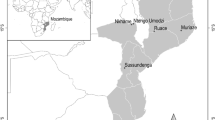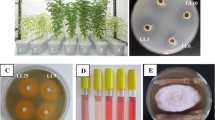Abstract
Peanut (Arachis hypogaea L.) is an important crop for the family-based systems in the tropics, mainly in Brazil. In the Brazilian drylands, peanuts are cropped in low technological systems, and cheap and efficient technologies are needed to improve crop yield and sustainability. Despite this importance, few data are available on selecting efficient peanut rhizobia in experiments under different edaphoclimatic conditions. This work evaluated the agronomic efficiency and the biological nitrogen fixation (BNF) by two elite Bradyrhizobium strains under four different fields in the Brazilian semiarid region. We compared a new efficient strain Bradyrhizobium sp. ESA 123 with the reference strain B. elkanii SEMIA 6144, currently used in peanut rhizobial inoculants in Brazil. Besides the inoculated treatments, two uninoculated controls were assessed (with and without 80 kg ha−1 of N-urea). The BNF was estimated by the δ15N approach in three out of four field assays. BNF contribution was improved by inoculation of both Bradyrhizobium strains, ranging from 42 to 51% in Petrolina and 43 to 60% in Nossa Senhora da Glória. Peanuts’ yields benefited from the inoculation of both strains and N fertilization in all four assays. Nevertheless, the results showed the efficiency of both strains under different edaphoclimatic conditions, indicating the native strain ESA 123 as a potential bacterium for recommendation as inoculants for peanuts in Brazil, mainly in drylands.

Similar content being viewed by others
References
FAOSTAT. No title. Agricultural statistics - groundnuts. Published 2020. Accessed March 30, 2021. http://www.fao.org/faostat/en/#data/QC
CONAB. Séries históricas. Published 2022. Accessed May 10, 2022. https://www.conab.gov.br/info-agro/safras/serie-historica-das-safras?start=20
dos Santos RC (2005) O Agronegócio do Amendoim no Brasil. Empresa Brasileira de Pesquisa Agropecuária. https://books.google.com.br/books?id=O0K6ZwEACAAJ
Volpiano CG, Lisboa BB, José JFB de S, Beneduzi A, Granada CE, Vargas LK (2022) Soil-plant-microbiota interactions to enhance plant growth. Rev Bras Ciência do Solo 46:e0210098. https://doi.org/10.36783/18069657RBCS20210098
de Souza R, Ambrosini A, Passaglia LMP (2015) Plant growth-promoting bacteria as inoculants in agricultural soils. Genet Mol Biol 38(4):401–419. https://doi.org/10.1590/S1415-475738420150053
Brasil (2011) Instrução Normativa No 13/2011 - Normas Sobre Especificações, Garantias, Registro, Embalagem e Rotulagem Dos Inoculantes Destinados à Agricultura, Das Especificações, Garantias Mínimas e Tolerâncias Dos Produtos. Ministério da Agricultura Pecuária e Abastecimento. https://www.gov.br/agricultura/pt-br/assuntos/insumos-agropecuarios/insumos-agricolas/fertilizantes/legislacao/in-sda-13-de-24-03-2011-inoculantes.pdf
Sizenando CIT, Ramos JPC, Fernandes-Junior PI, de Lima LM, Freire RMM, dos Santos RC (2016) Agronomic efficiency of Bradyrhizobium in peanut under different environments in Brazilian Northeast. African J Agric Res 11(37):3482–3487. https://doi.org/10.5897/AJAR2016.11294
Valetti L, Angelini JG, Taurian T, Anzuay MS, Fabra A, Cerioni GA (2016) Development and field evaluation of liquid inoculants with native bradyrhizobial strains for peanut production. African Crop Sci J 24(1):1–13
Cardoso JD, Gomes DF, Goes KCGP et al (2009) Relationship between total nodulation and nodulation at the root crown of peanut, soybean and common bean plants. Soil Biol Biochem 41(8):1760–1763. https://doi.org/10.1016/j.soilbio.2009.05.008
Bogino P, Banchio E, Giordano W (2010) Molecular diversity of peanut-nodulating rhizobia in soils of Argentina. J Basic Microbiol 50(3):274–279. https://doi.org/10.1002/jobm.200900245
Nievas F, Bogino P, Nocelli N, Giordano W (2012) Genotypic analysis of isolated peanut-nodulating rhizobial strains reveals differences among populations obtained from soils with different cropping histories. Appl Soil Ecol. 53(1):74–82. https://doi.org/10.1016/j.apsoil.2011.11.010
Muñoz V, Ibañez F, Tonelli ML, Valetti L, Anzuay MS, Fabra A (2011) Phenotypic and phylogenetic characterization of native peanut Bradyrhizobium isolates obtained from Córdoba, Argentina. Syst Appl Microbiol. https://doi.org/10.1016/j.syapm.2011.04.007
Torres-Júnior CV, Leite J, Santos CE de R e S et al (2014) Diversity and symbiotic performance of peanut rhizobia from Southeast region of Brazil. African J Microbiol Res 8(6):566–577. https://doi.org/10.5897/AJMR2013.5883
Santos CER, Stamford NP, Neves MCP et al (2007) Diversidade de rizóbios capazes de nodular leguminosas tropicais. Rev Bras Ciências Agrárias - Brazilian J Agric Sci. 2(4):249–256. https://doi.org/10.5039/agraria.v2i4a374
Lyra M do CCP de, de Freitas ADS, Silva TA, Santos CERS (2013) Phenotypic and molecular characteristics of rhizobia isolated from nodules of peanut (Arachis hypogaea L.) grown in Brazilian Spodosols. African J Biotechnol 12(17):2147–2156. https://doi.org/10.5897/ajb11.1574
dos Santos JWM, da Silva JF, Ferreira TDS et al (2017) Molecular and symbiotic characterization of peanut bradyrhizobia from the semi-arid region of Brazil. Appl Soil Ecol 121(12):177–184. https://doi.org/10.1016/j.apsoil.2017.09.033
Jain D, Sanadhya S, Saheewala H et al (2020) Molecular diversity analysis of plant growth promoting rhizobium isolated from groundnut and evaluation of their field efficacy. Curr Microbiol 77(8):1550–1557. https://doi.org/10.1007/S00284-020-01963-Y/FIGURES/2
Mburu SW, Koskey G, Njeru EM, Ombori O, Maingi JM, Kimiti JM (2020) Differential response of promiscuous soybean to local diversity of indigenous and commercial Bradyrhizobium inoculation under contrasting agroclimatic zones. Int J Plant Prod. 14(4):571–582. https://doi.org/10.1007/S42106-020-00117-1
Mercante FM, Otsubo AA, Brito OR (2017) New native rhizobia strains for inoculation of common bean in the Brazilian savanna. Rev Bras Ciênc Solo 41:150120. https://doi.org/10.1590/18069657rbcs20150120
Xavier GR, Runjanek NG, Santos CE de R e. S et al (2017) Agronomic effectiveness of rhizobia strains on cowpea in two consecutive years. Aust J Crop Sci 11(9):1154–1160. https://doi.org/10.21475/ajcs.17.11.09.pne715
Cunha JBA (2014) Diversidade de Isolados de Rizóbio Nodulantes de Acessos de Amendoim (Arachis Hypogaea L.) Cultivados em Solos do Nordeste do Brasil. UNEB
de Melo EBS, de Lima LM, Fernandes-Júnior PI et al (2016) Nodulation, gas exchanges and production of peanut cultivated with Bradyrhizobium in soils with different textures. Comun Sci 7(2):160. https://doi.org/10.14295/cs.v7i2.1449
Barbosa DD, Brito SL, Fernandes PD, Fernandes-Júnior PI, de Lima LM (2018) Can Bradyrhizobium strains inoculation reduce water deficit effects on peanuts? World J Microbiol Biotechnol 34(12):87. https://doi.org/10.1007/s11274-018-2474-z
Brito SL, Santos AB, Barbosa DD, Fernandes PD, Fernandes-Júnior PI, Lima LM (2019) Bradyrhizobium spp. As attenuators of water deficit stress in runner peanut genotypes based on physiological and gene expression responses. Genet Mol Res 18(4):gmr18379. https://doi.org/10.4238/gmr18379
dos Santos AB, Gondim TM de S, Fernandes Júnior PI, de Lima LM (2021) Effect of fungicides on the symbiosis between Bradyrhizobium strains and peanut. Pesqui Agropecuária Trop 51:e69089. https://doi.org/10.1590/1983-40632021v5169089.2
Vincent JM (1970) A manual for the practical study of root nodule bacteria. Blackwell Scientific, Oxford
Santos HG, Jacomine PKT, Anjos LHC dos et al (2014) Sistema Brasileiro de Classificação de Solos. doi:ISBN 978–85–7035–198–2
Teixeira PC, Donagemma GK, Fontana A, Teixeira WG eds (2017) Manual de Métodos de Análise de Solo, 3rd ed. Empresa Brasileira de Pesquisa Agropecuária
Cavalcanti FJ de A (1998) Recomendações de Adubação Para o Estado de Pernambuco: Segunda Aproximação, 2nd ed. Instituto Agronômico de Pernambuco
Hungria M, Araujo RS (1994) Manual de Métodos Empregados em Estudos de Microbiologia Agrícola, 1st edn. Empresa Brasileira de Pesquisa Agropecuária
Shearer G, Kohl DH (1986) N2-fixation in field settings: estimations based on natural 15N abundance. Aust J Plant Physiol 13:699–756. https://doi.org/10.1071/PP9860699c
Unkovich M, Herridge D, Peoples M et al (2008) Measuring plant-associated nitrogen fixation in agricultural systems. Australian Council for International Agricultural Research (ACIAR)
Ferreira DF (2011) Sisvar: a computer statistical analysis system. Cienc e Agrotecnologia 35:1039–1042
Hammer Ø, Harper DAT, Ryan PD, Ryan DD, Ryan PD (2011) PaSt: Paleontological statistics software package for education and data analysis. Palaentologia Electron 4(4):5–7. https://doi.org/10.1016/j.bcp.2008.05.025
Martins LMV, Xavier GR, Rangel FW et al (2003) Contribution of biological nitrogen fixation to cowpea: a strategy for improving grain yield in the semi-arid region of Brazil. Biol Fertil Soils 38(6):333–339. https://doi.org/10.1007/s00374-003-0668-4
Marinho R de CN, Nóbrega RSA, Zilli JE et al (2014) Field performance of new cowpea cultivars inoculated with efficient nitrogen-fixing rhizobial strains in the Brazilian Semiarid. Pesqui Agropecu Bras 49(5). https://doi.org/10.1590/S0100-204X2014000500009
Borges WL, dos Santos FN, da Mota RR, Rumjanek NG (2021) Liming, fertilization, and rhizobia inoculation on cowpea yield in a Brazilian Amazon upland forest environment. Pesqui Agropecuária Bras 56:1–7. https://doi.org/10.1590/S1678-3921.PAB2021.V56.02191
Zilli JÉ, Marson LC, Marson BF, Rumjanek NG, Xavier GR (2009) Contribuição de estirpes de rizóbio para o desenvolvimento e produtividade de grãos de feijão-caupi em Roraima. Acta Amaz 39(4):749–758. https://doi.org/10.1590/S0044-59672009000400003
Silva Júnior EB, Favero VO, Xavier GR, Boddey RM, Zilli JE (2018) Rhizobium inoculation of cowpea in Brazilian Cerrado increases yields and nitrogen fixation. Agron J 110(2):722–727. https://doi.org/10.2134/agronj2017.04.0231
Boddey RM, Fosu M, Atakora WK et al (2017) Cowpea (Vigna unguiculata) crops in Africa can respond to inoculation with rhizobium. Exp Agric 53(4):578–587. https://doi.org/10.1017/S0014479716000594
Okito A, José Rodrigues Alves B, Urquiaga S, Michael Boddey R (2004) Nitrogen fixation by groundnut and velvet bean and residual benefit to a subsequent maize crop. Pesqui Agropecuária Bras 39(12):1183–1190
Zilli JÉ, Pacheco RS, Gianluppi V, Smiderle OJ, Urquiaga S, Hungria M (2021) Biological N2 fixation and yield performance of soybean inoculated with Bradyrhizobium. Nutr Cycl Agroecosystems 119(3):323–336. https://doi.org/10.1007/S10705-021-10128-7/TABLES/8
Dantas EF, de Freitas ADS, de Lyra M do CCP et al (2019) Biological fixation, transfer and balance of nitrogen in passion fruit (Passiflora edulis Sims) orchard intercropped with different green manure crops. Aust J Crop Sci 13(3):465–471. https://doi.org/10.21475/ajcs.19.13.03.p1559
Freitas ADS de, Silva AF, Sampaio EV de SB (2012) Yield and biological nitrogen fixation of cowpea varieties in the semi-arid region of Brazil. Biomass Bioenergy 45. https://doi.org/10.1016/j.biombioe.2012.05.017
Martins JCR, de Freitas ADS, Menezes RSC, Sampaio EV de SB (2015) Nitrogen symbiotically fixed by cowpea and gliricidia in traditional and agroforestry systems under semiarid conditions. Pesqui Agropecu Bras 50(2):178–184. https://doi.org/10.1590/S0100-204X2015000200010
Acknowledgements
We are grateful for the several students and technicians that helped us during the field experiments.
Funding
The Brazilian Council for Scientific and Technological Development (CNPq), INCT–Plant Growth–Promoting Microorganisms for Agricultural Sustainability and Environmental Responsibility (CNPq/Fundação Araucária STI/CAPES INCT-MPCPAgro 465133/2014–4), and the Brazilian Agricultural Research Corporation (Embrapa 23.16.05.016.00.00) provided financial support.
The Pernambuco State Science Foundation (Facepe) awarded scholarships to the second author. Facepe (APQ 0271–5.01/19) and CNPq (316042/2020–0) also awarded the postdoc fellowship to the nineth author. The tenth and last authors are research fellows of CNPq (306812/2018–5 and 311218/2017–2, respectively).
Author information
Authors and Affiliations
Contributions
LML, RCS, CERSS, ADSF, LMVM, and PIF-J conceived the research project; RSJ and PIF-J implemented and collected all field assays; RSJ, TRS, RTR, JRSC, and JBAC processed and analyzed all plant material collected in the fields; ADSF and CERSS conducted the isotopic analyzes; PRAR, ADSF, and PIF-J analyzed all data; PRAR and PIF-J wrote the manuscript; all authors read and approved the final manuscript version.
Corresponding author
Ethics declarations
Competing interests
The authors declare no competing interests.
Additional information
Responsible Editor: Marco Antonio Nogueira
Publisher's note
Springer Nature remains neutral with regard to jurisdictional claims in published maps and institutional affiliations.
Rights and permissions
About this article
Cite this article
Jovino, R.S., da Silva, T.R., Rodrigues, R.T. et al. Elite Bradyrhizobium strains boost biological nitrogen fixation and peanut yield in tropical drylands. Braz J Microbiol 53, 1623–1632 (2022). https://doi.org/10.1007/s42770-022-00792-4
Received:
Accepted:
Published:
Issue Date:
DOI: https://doi.org/10.1007/s42770-022-00792-4




